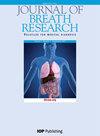呼吸系统疾病中的呼出气体冷凝物(EBC):Omic 科学时代的最新进展和未来展望。
IF 3.4
4区 医学
Q1 BIOCHEMICAL RESEARCH METHODS
引用次数: 0
摘要
呼出气体冷凝物(EBC)是呼吸医学领域一种前景广阔的无创诊断工具。EBC 是通过冷却呼出的空气实现的,呼出的空气中含有气溶胶颗粒和挥发性化合物。这种方法可提供有关气道生化和炎症状态的有用信息。在哮喘、慢性阻塞性肺病 (COPD) 和囊性纤维化等呼吸系统疾病中,EBC 分析可揭示过氧化氢、一氧化氮和各种细胞因子等生物标记物水平的升高,这些标记物与氧化应激和炎症相关。EBC 采样的非侵入性使其特别适用于重复测量,也适用于包括儿童和老人在内的易感人群。尽管EBC具有很大的潜力,但其采集方法、分析技术和结果解释的标准化目前限制了它在临床实践中的应用。 在本教程中,我们将介绍气道疾病EBC研究的最新进展以及EBC分析临床应用的未来前景,包括应用Omic科学进行分析。本文章由计算机程序翻译,如有差异,请以英文原文为准。
Exhaled breath condensate (EBC) in respiratory diseases: Recent advances, and future perspectives in the age of Omic sciences.
Exhaled breath condensate (EBC) is used as a promising noninvasive diagnostic tool in the field of respiratory medicine. EBC is achieved by cooling exhaled air, which contains aerosolized particles and volatile compounds present in the breath. This method provides useful information on the biochemical and inflammatory state of the airways. In respiratory diseases such as asthma, chronic obstructive pulmonary disease (COPD) and cystic fibrosis, EBC analysis can reveal elevated levels of biomarkers such as hydrogen peroxide, nitric oxide and various cytokines, which correlate with oxidative stress and inflammation.
Furthermore, the presence of certain volatile organic compounds (VOCs) in EBC has been linked to specific respiratory conditions, potentially serving as disease-specific fingerprints. The noninvasive nature of EBC sampling makes it particularly useful for repeated measures and for use in vulnerable populations, including children and the elderly. Despite its potential, the standardization of collection methods, analytical techniques and interpretation of results currently limits its use in clinical practice.
Nonetheless, EBC holds significant promise for improving the diagnosis, monitoring and therapy of respiratory diseases.
In this tutorial we will present the latest advances in EBC research in airway diseases and future prospects for clinical applications of EBC analysis, including the application of the Omic sciences for its analysis.
.
求助全文
通过发布文献求助,成功后即可免费获取论文全文。
去求助
来源期刊

Journal of breath research
BIOCHEMICAL RESEARCH METHODS-RESPIRATORY SYSTEM
CiteScore
7.60
自引率
21.10%
发文量
49
审稿时长
>12 weeks
期刊介绍:
Journal of Breath Research is dedicated to all aspects of scientific breath research. The traditional focus is on analysis of volatile compounds and aerosols in exhaled breath for the investigation of exogenous exposures, metabolism, toxicology, health status and the diagnosis of disease and breath odours. The journal also welcomes other breath-related topics.
Typical areas of interest include:
Big laboratory instrumentation: describing new state-of-the-art analytical instrumentation capable of performing high-resolution discovery and targeted breath research; exploiting complex technologies drawn from other areas of biochemistry and genetics for breath research.
Engineering solutions: developing new breath sampling technologies for condensate and aerosols, for chemical and optical sensors, for extraction and sample preparation methods, for automation and standardization, and for multiplex analyses to preserve the breath matrix and facilitating analytical throughput. Measure exhaled constituents (e.g. CO2, acetone, isoprene) as markers of human presence or mitigate such contaminants in enclosed environments.
Human and animal in vivo studies: decoding the ''breath exposome'', implementing exposure and intervention studies, performing cross-sectional and case-control research, assaying immune and inflammatory response, and testing mammalian host response to infections and exogenous exposures to develop information directly applicable to systems biology. Studying inhalation toxicology; inhaled breath as a source of internal dose; resultant blood, breath and urinary biomarkers linked to inhalation pathway.
Cellular and molecular level in vitro studies.
Clinical, pharmacological and forensic applications.
Mathematical, statistical and graphical data interpretation.
 求助内容:
求助内容: 应助结果提醒方式:
应助结果提醒方式:


